Chapter: 11th 12th std standard Class Organic Inorganic Physical Chemistry Higher secondary school College Notes
Miller Indices
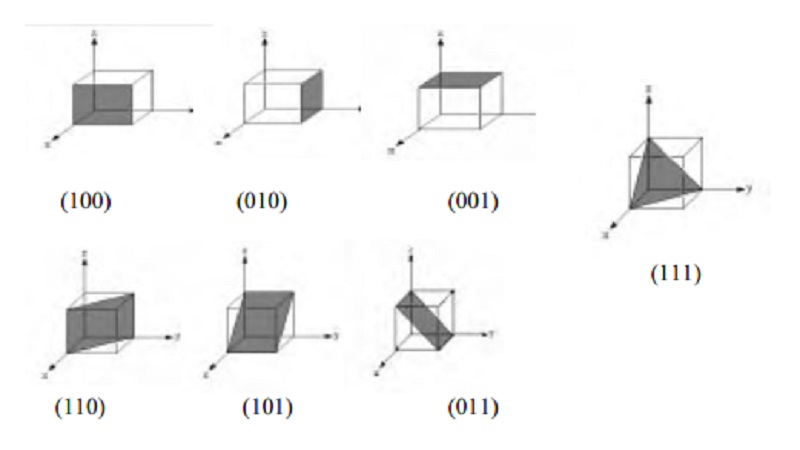
Miller Indices
The
geometry of a crystal may be completely defined with the help of coordinate
axes all meeting at a point (origin). The number and inclination of these
crystal intercept them at definite distances from the origin or are parallel to
some of the axes, i.e., intercepting at infinity. The law of rational indices
or intercepts states that it is possible to choose along the three coordinate
axes unit distances (a, b, c) not necessarily of the same length such that the
ratio of the intercepts of any plane in the crystal is given by (la : mb : nc)
where l, m and n are simple integers like 1, 2, 3 or fractions of whole
numbers.
For
example consider plane LMN in the crystal shown in Fig.
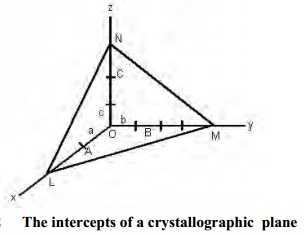
This plane has intercepts OL, OM and ON along
the x-, y- and z-axes at distances 2a, 4b and 3c respectively, when OA = a, OB
= b and OC = c are the chosen unit distances along the three coordinates. These
intercepts are in the ratio of 2a : 4b : 3c wherein 2, 4, 3 are simple integral
whole numbers.
The coefficients of a, b and c (2, 4 and 3 in this case) are known as
the Weiss indices of a plane. It may be borne in mind that the Weiss indices
are not always simple integral whole numbers as in this case. They may have
fractional values as well as infinity (an indefinite quantity). Weiss indices
are, therefore, rather awkward in use and have consequently been replaced by
miller indices. Taking the reciprocals of Weiss indices and multiplying
throughout by the smallest number in order to make all reciprocals as integers
obtain the Miller indices of a
plane. The Miller indices for a particular family of planes are usually written
(h, k, l) where h, k and l are
positive or negative integers or zero.
Consider a
plane which in Weiss notation is given by 2 a: 4b: 3c. Taking reciprocals of
coefficients of a, b and c, we get the ratio 1/2, 1/4, 1/3. Multiplying by 12
in order to convert them into whole numbers, we get 6, 3, 4. These numbers are
called the Miller indices of the plane, and the plane is designated as the
(634) plane. In (634) plane, h = 6, k = 3 and l = 4.
Similarly the Miller's indices for the plane which the Weiss notation is
given by ¥ a : 2b :
c. Taking reciprocals of coefficients of a, b and c, we get the ratio 1/¥, 1/2, 1/1, i.e., 0, 1/2, 1. Multiplying by 2 in
order to convert them into whole numbers, we get 0, 1, 2. The plane is
designated as the (012) plane in which , h = 0, k = 1 and l = 2.
The distances between parallel planes in a crystal are designated as dhkl.
For different cubic lattices these interplanar spacings are given by the
general formula
dhkl = a / root of(h2
+ k2 + l2)
Where a
is the length of the cube side while h, k and l are the Miller indices of the
plane.
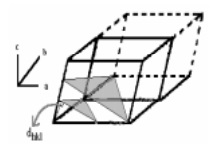
Definition of Miller Indices in three dimensions
A pair of planes with Miller indices (213)
The Miller
indices of a face of a crystal are inversely proportional to the intercepts
of that face on the various axes.
The Miller indices of this
particular family of planes are given by the reciprocals of the fractional
intercepts along each of the cell directions. E.g. 1/2 x a, 1x b, 1/3 x c.
The procedure for determining the miller indices
for a plane is as follows:
1.
Prepare a three-column table with the unit cell
axes at the tops of the columns.
2.
Enter in each column the intercept (expressed as
a multiple of a, b or c) of the plane with these axes.
3.
Invert all numbers.
4.
Clear fractions to obtain h, k and l.
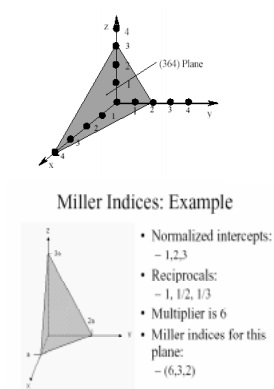
Consider the x-, y-, z- axes in the above figure with the dots
representing atoms in a single crystal lattice. To determine the Miller
indices, one finds the intercepts on the three axis. The intercepts are: x = 4,
y = 2 and z = 3. Then the reciprocals are taken, ie., ¼, ½, 1/3 and finally
these fractions are reduced to the smallest integers, ie., 3, 6, 4 by 12. These
are the Miller indices represented as (364).
Let us look at the most common planes in a cube,
shown below in figure. As an example the front crystal face shown here
intersects the x-axis but does not intersect the y- or z -axes but parallel to
y and z axis. The front crystal face intersects only one of the
crystallographic axes(x-axes). So the miller indices for the plane is (100).
The side plane has intercepts
x = ¥, y = 1, z
= ¥ because
the plane is parallel to the x- and z-axes, forming the Miller indices gives
(010). The top plane has intercepts x = ¥, y = ¥ , z = 1
because the plane is parallel to the x- and y- axes , forming the Miller indices gives (001).
The (110) plane intercepts x=1, y=1 and z= ¥ which is parallel to z-axis. Similarly the
other two planes are (101) and (011). The (111) plane intercepts all the three
axes x=1, y=1 and z=1.
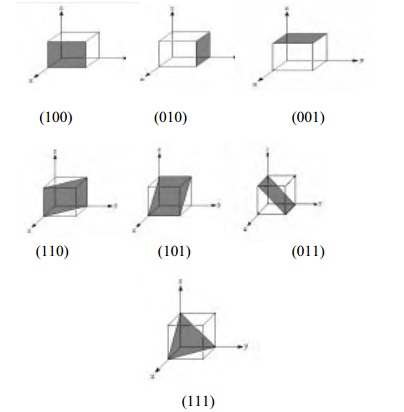
Related Topics